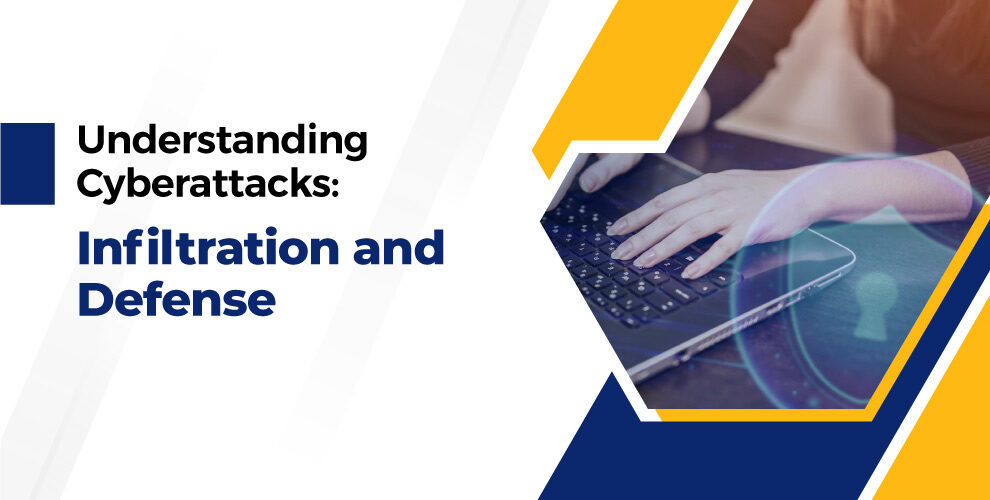Digitalization growth also comes with the negative side effects of cybercrime. And it is evident that businesses need cybersecurity professionals to avoid being victims of a cyberattack. Thus, the importance of cybersecurity professionals is in demand, and the BE cybersecurity colleges in Tamil Nadu understand today’s need. Additionally, hackers today have sophisticated tools and methods for gaining access to your network infrastructure.
Once they get to know the organization’s security operations, they look for security flaws, enter targeted systems, and cause damage. Hence, from administrative to individual clients, security is a main concern for all business operations. This article gives a detailed glimpse into the anatomy of a cyberattack and how to safeguard against infiltrated systems.
Let’s start with the anatomy of cyberattack. What do you need to know?
Did you ever hear the term Reconnaissance?
It means surveillance, where the cyberattack begins with this. Hackers begin with research and acquiring data regarding their target company. Start with the IP addresses, domain names, network ranges, and email addresses of key players like CFOs and IT experts.
If the hackers are unable to locate the email addresses of key players, they will send phishing emails to employees who are at risk. With network vulnerabilities or employee entry email addresses, hackers are not easy to proceed to the next stage.
When to take action?
In this stage, hackers decide to attack when they get to know the gateway for the company network. However, they require access privileges to freely access the network. There are tools and devices that assist them in stealing credentials, which helps upgrade their access to company executive privileges.
Then, hackers can silently traverse the network and gain access to the entire system. Then encrypt the data to demand a ransom or obtain sensitive information for online sales. Now and then, programmers may likewise adjust or eradicate sensitive information for reasons beyond financial benefit.
Extend the search.
When hackers safely crack your company network, then the next phase of the anatomy is expansion. Now there is malicious software, which makes it easier for hackers to enter the network system.
And the gain is that they can easily get access to the multiple systems in the company, and the possibility of regaining access to the network is high after being detected. This led the hackers to no longer require higher access to enter the company networks.
Disarranging the entrance.
It means the hackers usually hide their origins of attacks with masks. This will help hackers safely exploit the system and avoid getting caught. The purpose of disarranging or jumbling is to confuse the cyber professionals and escape legal.
There are tools and techniques that hackers usually consider: spoofing, log cleaning, and zombie accounts. Cybersecurity experts have concluded that disarranging the patterns is the final stage of the anatomy of a cyberattack.
How to safeguard and understand cyberattacks?
Cyber professionals are required to think in different ways and stay alert when it comes to using digitalization. B.Sc. Computer Technology colleges in Coimbatore ensure the engineers get to know the reasons and guess the possibility behind the story of these attacks. Here is a list of how cyber professionals are required to act when they end up in such a critical scenario.
The motive behind the attacks is the foremost thing. The common intention behind the hacking or cyberattack is financial advantage. It is certain that hackers encrypt or steal data in exchange for ransom or try to sell the data online. The second common intention is to harm the company personally or officially, causing damage to the company’s reputation, spreading fear, or diverting authorities to prepare for the dangerous attacks.
The need for a cybersecurity department in organizations is mandatory so that you can prevent or protect your company from cyberattacks. This also assists you in developing a strategy to prevent a cyberattack and minimize its effects. Therefore, it is better to start recruiting engineers who have the technical skills to manage the cyberattacks.
Let’s discuss the common aspects your cybersecurity efforts should include in an organization:
- Assess and check systems and networks for any detection of vulnerabilities.
- Protect the network with a secure firewall and antivirus from malware.
- Encrypt the organizational data and set warning alerts for data disturbances.
- Regular hardware and software audits keep the IT systems strong.
- Better employees can be trained to understand cyberattacks, take preventive measures, and respond to cyberattacks.
To summarize, the above mentions the anatomy of cyberattacks and where organizations need to update if they lack network security. B.Com. Computer Application colleges in Coimbatore include the basic concepts of how to secure your data and detailed explanations of cyberattacks. Hope this guide lets you know how hackers work to prepare for a counterattack.


